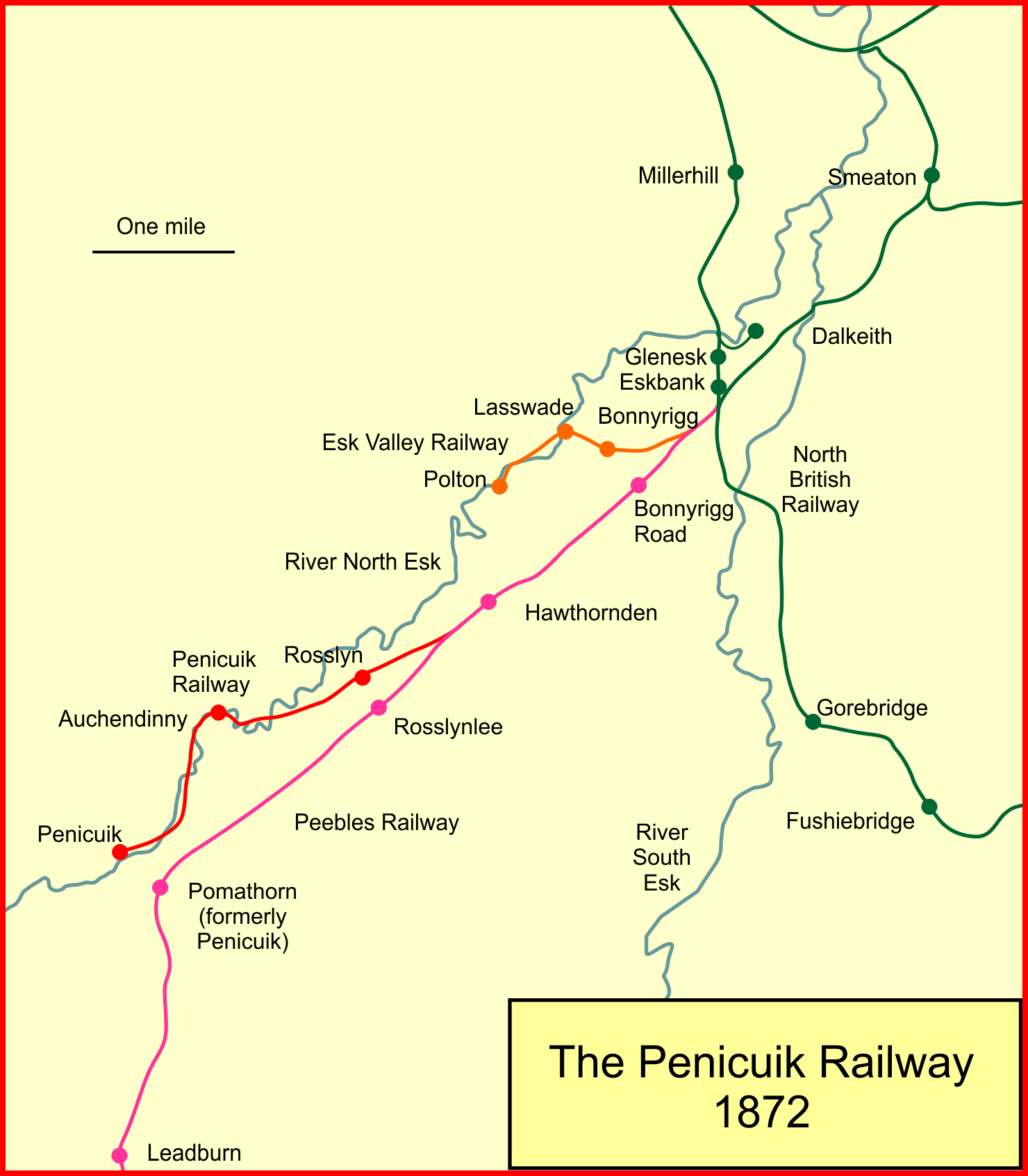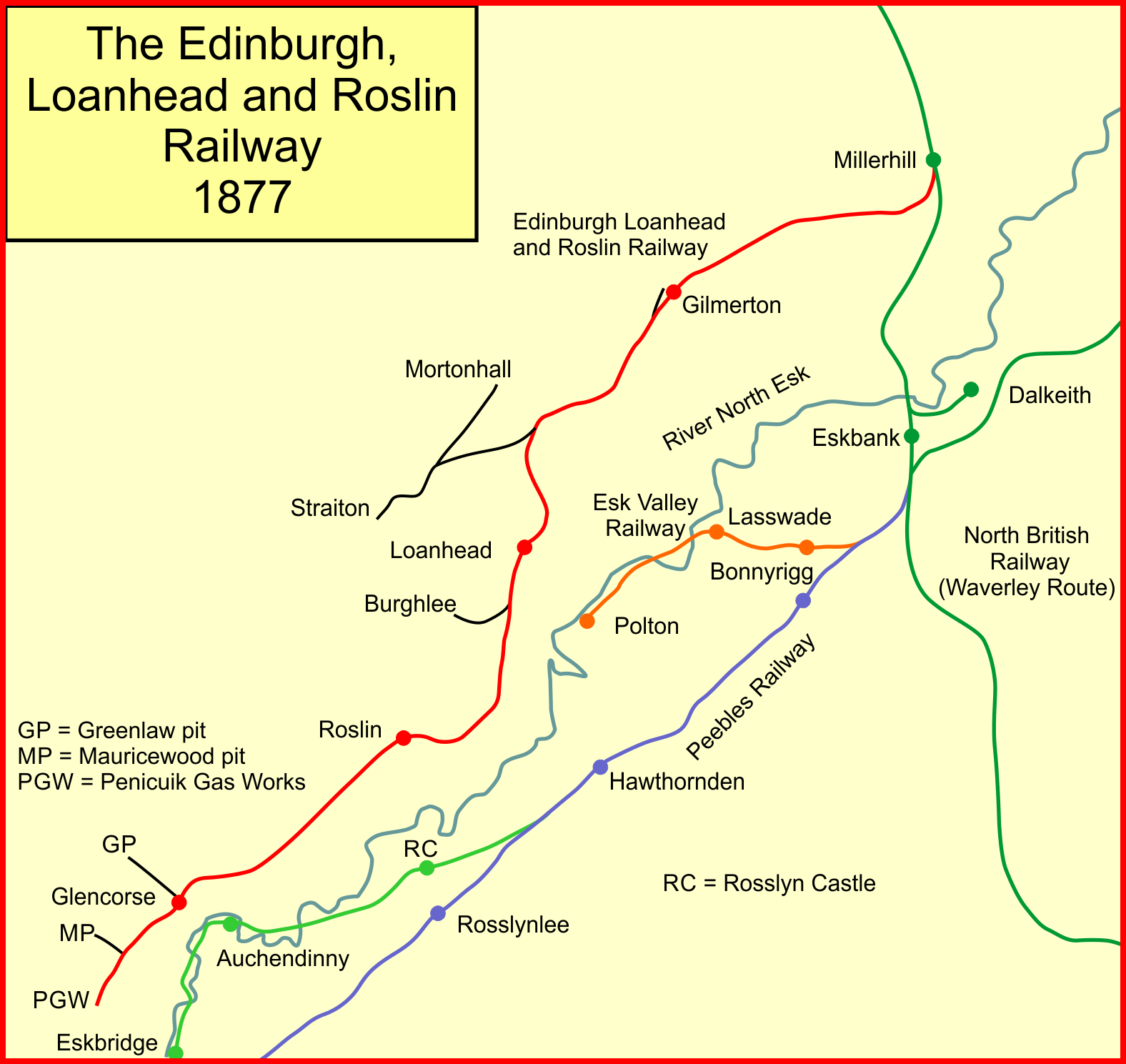|
Mauricewood Colliery Disaster
The Mauricewood Colliery Disaster, occurred at the Mauricewood pit, near Penicuik, Midlothian, Scotland on 5 September 1889. A total of 63 miners were killed. At the time the mine was owned by the Shotts Iron Company Ltd. Fire and rescue operation On 5 September 1889 at around noon sections of the wood lining of a ventilation shaft ignited and the ensuing fire spread to a nearby coal seam, making an escape on the 239m deep main shaft impossible. At that time 70 men and boys were working underground, of which 63 died and 7 survived. The underground fire took four days to extinguish. It was not until 16 March 1890 that all the bodies of the victims were recovered. Aftermath The cause of the fire was never determined although it led to the pit being closed which caused major losses to the two local railway lines, the Penicuik Railway and the Edinburgh, Loanhead and Roslin Railway The Edinburgh, Loanhead and Roslin Railway was a railway line south of Edinburgh, Scotland, built prim ... [...More Info...] [...Related Items...] OR: [Wikipedia] [Google] [Baidu] |
Penicuik
Penicuik ( ; sco, Penicuik; gd, Peighinn na Cuthaig) is a town and former burgh in Midlothian, Scotland, lying on the west bank of the River North Esk. It lies on the A701 midway between Edinburgh and Peebles, east of the Pentland Hills. Name The town's name is pronounced 'Pennycook' and is derived from ''Pen Y Cog'', meaning "Hill of the Cuckoo" in the British language (Celtic), Old Brythonic language (also known as Ancient British and the forerunner of modern Welsh language, Welsh). History In 1296, Thomas Rymer's ''Foedera'' mentions a "Walter Edgar a person of Penicok south of Edenburgh", which logically can only be what is now called Penicuik. Penycook appears as the name on John Adair's map of 1682 and the ruined old parish church, in the centre of the graveyard, dates from the late 17th century. Penicuik became home to an early paper mill, Valleyfield Mill, which was established by Agnes Campbell (printer), Agnes Campbell in 1709. The Pomathorn Bridge was a toll b ... [...More Info...] [...Related Items...] OR: [Wikipedia] [Google] [Baidu] |
Midlothian
Midlothian (; gd, Meadhan Lodainn) is a historic county, registration county, lieutenancy area and one of 32 council areas of Scotland used for local government. Midlothian lies in the east-central Lowlands, bordering the City of Edinburgh, East Lothian and the Scottish Borders. Midlothian emerged as a county in the Middle Ages under larger boundaries than the modern council area, including Edinburgh itself. The county was formally called the "shire of Edinburgh" or Edinburghshire until the twentieth century. It bordered West Lothian to the west, Lanarkshire, Peeblesshire and Selkirkshire to the south, and East Lothian, Berwickshire and Roxburghshire to the east. Traditional industries included mining, agriculture and fishing – although the modern council area is now landlocked. History Following the end of the Roman occupation of Britain, Lothian was populated by Brythonic-speaking ancient Britons and formed part of Gododdin, within the Hen Ogledd or Old North. In the ... [...More Info...] [...Related Items...] OR: [Wikipedia] [Google] [Baidu] |
Scotland
Scotland (, ) is a country that is part of the United Kingdom. Covering the northern third of the island of Great Britain, mainland Scotland has a border with England to the southeast and is otherwise surrounded by the Atlantic Ocean to the north and west, the North Sea to the northeast and east, and the Irish Sea to the south. It also contains more than 790 islands, principally in the archipelagos of the Hebrides and the Northern Isles. Most of the population, including the capital Edinburgh, is concentrated in the Central Belt—the plain between the Scottish Highlands and the Southern Uplands—in the Scottish Lowlands. Scotland is divided into 32 administrative subdivisions or local authorities, known as council areas. Glasgow City is the largest council area in terms of population, with Highland being the largest in terms of area. Limited self-governing power, covering matters such as education, social services and roads and transportation, is devolved from the Scott ... [...More Info...] [...Related Items...] OR: [Wikipedia] [Google] [Baidu] |
Penicuik Railway
The Penicuik Railway was a railway line in Midlothian, Scotland, serving paper mills located on the River North Esk. It opened in 1872 and a substantial residential passenger traffic built up. The line was 4 1/2 miles long. Passenger usage fell off sharply in the mid-twentieth century and the passenger service was discontinued in 1951. A basic goods train service continued until the line finally closed to all traffic in 1967. There is no railway use of the line nowadays. History Before the Penicuik Railway By 1848 most of the great trunk railways of Scotland had been built, as well as a considerable number of branches. Communities in rural areas found that a railway connection reduced the cost of necessities considerably, and made it cheaper to get local manufactures to market. Conversely places without a railway suffered. The Peebles Railway opened in 1855, transforming the economy of the town. The Peebles Railway ran on high ground well to the east of the River North Esk. T ... [...More Info...] [...Related Items...] OR: [Wikipedia] [Google] [Baidu] |
Edinburgh, Loanhead And Roslin Railway
The Edinburgh, Loanhead and Roslin Railway was a railway line south of Edinburgh, Scotland, built primarily to serve mineral workings, although passenger trains were operated. It is also known as the ''Glencorse Branch'' of the North British Railway. It opened from a junction at Millerhill on the Waverley Route, to Roslin in 1874 and was extended to a location near Penicuik to serve Glencorse Barracks and a colliery in 1877 and to Penicuik Gas Works in 1878. Bus services substantially eroded the passenger carryings on the line, and passenger trains ceased in 1933. There was some revival in colliery activity after World War II but most of the traffic had ceased in 1969 and the line finally closed completely in 1989. History First proposals Many Scottish railways were authorised in the frenzy of schemes in Parliament in the 1845 session, including the Caledonian Railway; the North British Railway had been authorised the previous year. Earlier there had been a heated debate abou ... [...More Info...] [...Related Items...] OR: [Wikipedia] [Google] [Baidu] |
Coal Mining Disasters In Scotland
Coal is a combustible black or brownish-black sedimentary rock, formed as rock strata called coal seams. Coal is mostly carbon with variable amounts of other elements, chiefly hydrogen, sulfur, oxygen, and nitrogen. Coal is formed when dead plant matter decays into peat and is converted into coal by the heat and pressure of deep burial over millions of years. Vast deposits of coal originate in former wetlands called coal forests that covered much of the Earth's tropical land areas during the late Carboniferous ( Pennsylvanian) and Permian times. Many significant coal deposits are younger than this and originate from the Mesozoic and Cenozoic eras. Coal is used primarily as a fuel. While coal has been known and used for thousands of years, its usage was limited until the Industrial Revolution. With the invention of the steam engine, coal consumption increased. In 2020, coal supplied about a quarter of the world's primary energy and over a third of its electricity. Some iron a ... [...More Info...] [...Related Items...] OR: [Wikipedia] [Google] [Baidu] |
Coal Mines In Scotland
Coal is a combustible black or brownish-black sedimentary rock, formed as rock strata called coal seams. Coal is mostly carbon with variable amounts of other elements, chiefly hydrogen, sulfur, oxygen, and nitrogen. Coal is formed when dead plant matter decays into peat and is converted into coal by the heat and pressure of deep burial over millions of years. Vast deposits of coal originate in former wetlands called coal forests that covered much of the Earth's tropical land areas during the late Carboniferous ( Pennsylvanian) and Permian times. Many significant coal deposits are younger than this and originate from the Mesozoic and Cenozoic eras. Coal is used primarily as a fuel. While coal has been known and used for thousands of years, its usage was limited until the Industrial Revolution. With the invention of the steam engine, coal consumption increased. In 2020, coal supplied about a quarter of the world's primary energy and over a third of its electricity. Some i ... [...More Info...] [...Related Items...] OR: [Wikipedia] [Google] [Baidu] |
1886 Mining Disasters
Events January–March * January 1 – Upper Burma is formally annexed to British rule in Burma, British Burma, following its conquest in the Third Anglo-Burmese War of November 1885. * January 5–January 9, 9 – Robert Louis Stevenson's novella ''Strange Case of Dr Jekyll and Mr Hyde'' is published in New York and London. * January 16 – A resolution is passed in the German Parliament to condemn the Prussian deportations, the politically motivated mass expulsion of ethnic Poles and Jews from Prussia, initiated by Otto von Bismarck. * January 18 – Modern field hockey is born with the formation of The Hockey Association in England. * January 29 – Karl Benz patents the first successful gasoline-driven automobile, the Benz Patent-Motorwagen (built in 1885). * February 6–February 9, 9 – Seattle riot of 1886: Anti-Chinese sentiments result in riots in Seattle, Washington. * February 8 – The West End Riots following a popular meet ... [...More Info...] [...Related Items...] OR: [Wikipedia] [Google] [Baidu] |





